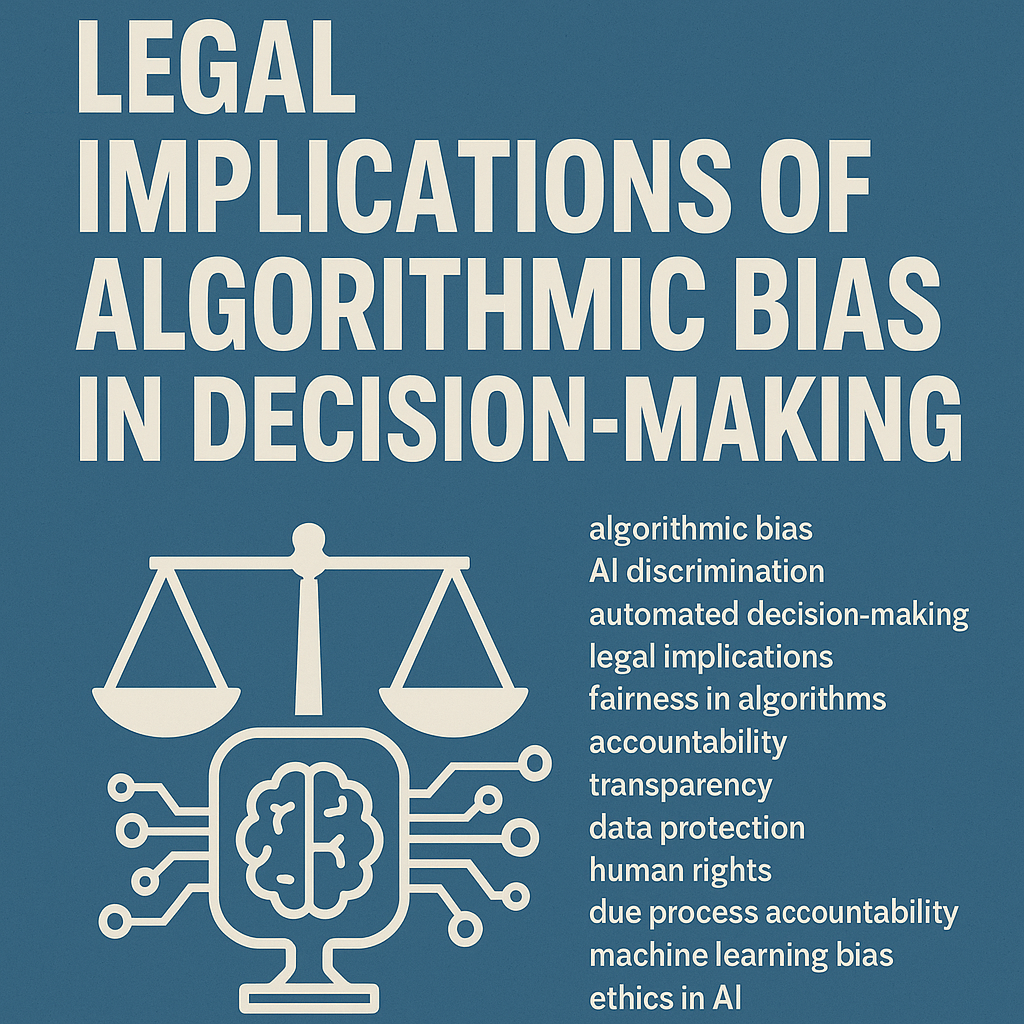Legal Implications of Algorithmic Bias in Decision-Making
Introduction
As artificial intelligence (AI) and algorithmic systems become central to decision-making in fields such as healthcare, criminal justice, finance, education, and employment, concerns about algorithmic bias have gained urgency. These automated systems, while often presented as objective and data-driven, can perpetuate and even exacerbate societal inequalities if not designed and deployed responsibly. This raises complex legal and ethical challenges regarding discrimination, accountability, transparency, and fairness.
This article explores the legal implications of algorithmic bias, examining how existing laws address (or fail to address) these challenges and highlighting the urgent need for legal reform and oversight mechanisms.
Understanding Algorithmic Bias
Algorithmic bias refers to systematic and repeatable errors in an algorithm that create unfair outcomes, such as privileging one group over another based on race, gender, age, socioeconomic status, or other protected characteristics. This bias can arise from various sources:
- Biased training data: Historical data used to train algorithms may reflect existing societal biases.
- Flawed algorithm design: Choices made during model development can unintentionally embed bias.
- Lack of diversity in development teams: Homogenous perspectives may overlook potential discriminatory impacts.
- Proxy variables: Seemingly neutral data (e.g., ZIP codes) may serve as proxies for protected attributes.
These biases can result in discriminatory practices that violate individuals’ rights and undermine public trust in automated systems.
Sectors Affected by Algorithmic Bias
1.
Criminal Justice
Predictive policing and risk assessment tools like COMPAS have been shown to disproportionately affect minority communities, raising questions about due process and equal protection under law.
2.
Employment
AI-driven hiring tools may replicate gender or racial biases from past hiring data, potentially violating anti-discrimination laws such as the Equal Employment Opportunity laws.
3.
Financial Services
Credit-scoring algorithms might deny loans or offer worse terms based on data correlated with race or geography, implicating fair lending regulations like the Equal Credit Opportunity Act (ECOA).
4.
Healthcare
Algorithms in diagnostics or resource allocation may provide inferior care recommendations for marginalized groups, challenging the principle of non-discrimination in medical treatment.
Legal Frameworks and Challenges
1. Anti-Discrimination Laws
Laws like Title VII of the U.S. Civil Rights Act, the UK Equality Act 2010, and India’s Constitution (Articles 14, 15, and 21) prohibit discrimination on grounds such as race, gender, religion, and caste. However, these laws often rely on the notion of intentional discrimination, while algorithmic bias is frequently unintentional or systemic, making legal redress difficult.
2. Data Protection and Privacy Laws
Regulations like the EU General Data Protection Regulation (GDPR) include provisions for automated decision-making (Article 22), granting individuals the right not to be subject to decisions based solely on automated processing that significantly affects them. It also mandates transparency and explainability, yet enforcement remains limited.
3. Due Process and Accountability
When algorithms are used by the state (e.g., for welfare eligibility or bail decisions), they must comply with due process rights. Lack of transparency in algorithmic decision-making raises concerns about procedural fairness, right to appeal, and access to reasons for decisions.
4. Lack of Legal Personhood and Responsibility
Algorithms cannot be held personally liable for harm. This raises complex questions about who is responsible—the developer, the deploying entity, the data provider, or the user? The legal system still lacks clear doctrines of liability in this context.
Judicial Responses and Case Studies
Courts around the world are beginning to grapple with algorithmic bias:
- State v. Loomis (Wisconsin, USA): The court upheld the use of a risk assessment tool in sentencing but acknowledged the tool’s lack of transparency and potential racial bias.
- Hélène Berr Foundation v. France (CNIL Decision): France’s data protection authority ruled against an AI system that used discriminatory scoring for student admissions.
- Delhi High Court Cases: Indian courts have started discussing algorithmic transparency in public decision-making, especially related to Aadhaar and welfare disbursements.
These cases reflect judicial awareness but also demonstrate the limitations of existing frameworks to adequately address the risks posed by AI systems.
Emerging Regulatory Trends
Governments and regulatory bodies are starting to introduce targeted policies:
- EU AI Act (Proposed): A risk-based approach to regulating AI, classifying systems as unacceptable, high, or low risk. High-risk systems (e.g., in hiring, policing) must meet strict requirements.
- U.S. Algorithmic Accountability Act (Proposed): Would require companies to conduct impact assessments for automated decision systems.
- India’s Digital Personal Data Protection Act, 2023: Focuses on consent and data minimization, though it doesn’t yet address algorithmic accountability in depth.
Key Legal Issues Arising from Algorithmic Bias
1.
Discrimination and Inequality
Algorithmic systems that replicate societal biases may entrench systemic discrimination, violating fundamental rights and equality principles.
2.
Lack of Transparency
“Black box” algorithms can obscure the logic behind decisions, making it difficult for individuals to challenge unjust outcomes or seek redress.
3.
Regulatory Gaps
Many jurisdictions lack specific laws governing AI, relying instead on outdated laws ill-suited for emerging technologies.
4.
Cross-Border Challenges
Global tech companies deploy AI systems across jurisdictions, creating legal conflicts and enforcement issues between national laws and corporate practices.
5.
Accountability and Redress
Without clear liability frameworks, victims of algorithmic bias may struggle to obtain compensation or corrective measures.
The Way Forward: Legal and Policy Recommendations
To address the legal implications of algorithmic bias, the following steps are essential:
1. Enact Clear AI Legislation
Governments must pass specific laws regulating algorithmic decision-making, incorporating principles of non-discrimination, fairness, and accountability.
2. Mandate Algorithmic Audits
Regular independent audits of AI systems should be required to assess bias, fairness, and transparency.
3. Strengthen Transparency Requirements
AI developers and deployers should be mandated to provide explainable outputs, impact assessments, and accessible documentation of how decisions are made.
4. Ensure Human Oversight
Critical decisions should not be made by algorithms alone. A “human-in-the-loop” approach should be required for high-impact decisions.
5. Expand Legal Remedies
Access to grievance redressal mechanisms, right to explanation, and appeals must be incorporated into both administrative and private sector AI systems.
6. Promote Ethical AI Development
Legal norms should be supported by ethical guidelines, ensuring that AI is developed and deployed in line with human rights principles.
Conclusion
Algorithmic bias poses significant threats to individual rights, legal equality, and democratic governance. As AI systems increasingly shape critical decisions in our lives, ensuring legal accountability and transparency becomes not just a technical issue, but a fundamental requirement of justice.
The law must evolve to recognize, regulate, and remediate the harms caused by biased algorithms. Through robust legislation, vigilant enforcement, and ethical innovation, we can build a future where technology serves fairness, inclusion, and equity—not entrenched bias and discrimination.







